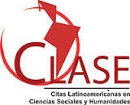Author Guidelines
Last update of editorial policies and guidelines for authors: 2024/12/20
Mediações publishes unpublished texts (free articles for continuous publication or for dossiers) in Portuguese, Spanish and English. It also has a review section, which is only published on our website. Under no circumstances should submissions be evaluated for publication by another journal (but they may have been deposited, as specified in our Open Science tab, in preprint repositories).
The articles, accompanied by a title, abstract and keywords (in Portuguese and English), should have a minimum size of 40,000 characters (with spaces) and a maximum of 60,000 characters (with spaces). The abstract, twelve lines maximum, should clearly define the subject under discussion. The keywords should clearly identify the subject under study, the theme or area of concentration of the article, and number between 3 and 5.
Authors need to submit keywords according to the guidelines for authors and Mediações also recommends that they be standardised according to the Brazilian Thesaurus of Information Science (IBICT), which recommends that the words selected represent the content of the document submitted to the journal. It also encourages the use of the CRediT taxonomy to represent information on the individual contribution of authors.
The following rules should also be observed:
a) The minimum qualification of the main author required for submission to the journal Mediações is a master's degree.
b) Only articles with at most 3 (three) authors will be accepted. All people involved in the production of the text must be registered as authors from the start of the submission process. In the case of submissions with more than one author, the parts written by each author, from initial research to the final writing up of the text, should be duly identified in a separate file, to be added as a Supplementary Document of Co-Authorship at the time of submission. Additionally, encourages the use of the CRediT taxonomy to represent information about the individual authors' contributions.
c) Authors who have published in Mediações must wait for an interval of two years before publication of a new article and 18 months after the previous publication date to begin a new submission process.
d) The text must be written in formal Portuguese and in compliance with the standards of ABNT NBR 6023. If the text is observed not to have been undergone an adequate grammatical and orthographical review to ensure it conforms to scholarly scientific language, the manuscript may be rejected.
e) Identification of the authorship of the work must be removed from the file and from the ‘Properties' option in Word. The rule is mandatory for both types of submission adopted by Mediações, double-blind evaluation and open evaluation.
f) Authors and co-authors must include their ORCID numbers in the identification data, as well as obligatory information (full name, full institutional affiliation, city, State, country, mini-curriculum, Lattes link, funding source(s), e-mail(s), possible Interest Conflicts).
g) Authors are entirely responsible for observing the rules of academic good practice, in particular those concerning plagiarism and self-plagiarism, described in the instructions contained in the journal's Plagiarism The maximum amount of self-citation accepted by Mediações is 5%.
h) Authors must ensure that their investigation follows the ethical and legal principles established by the documents that regulate ethical conduct in research involving human beings and/or animals in their area of knowledge, as indicated in journal's Ethical Principles section, complying with all the requirements determined by the specific legislation in force in the country in which the research was conducted; and that have attached, if applicable, a copy of the approval document from a research ethics committee as a supplementary document (titled 'Approval CEP') in the submission process.
i) Author(s) who wish to proceed with the informed evaluation modality confirm that they have completed and attached the specific evaluation form provided by SciELO to their submission.
j) It is mandatory for authors whose manuscripts are available in preprint servers to inform Mediações, at the time of submission, of the virtual location link of the article as well as its DOI, which should be inserted in the 'Comments for the Editor' box. Are aware that manuscripts previously deposited in preprint servers will always be subject to open review regarding the identification of the author(s).
Click here to make a new submission to the section: Rolling basis articles
Click here to make a new submission to the section: Dossier
Reviews of books not translated into Portuguese published over the last 5 years, published only on the Mediações website, should present both the central ideas of the author(s) and the critical considerations of the reviewer concerning the content of the book. They should contain a minimum of 9.000 characters (with spaces) and a maximum of 14,000 characters (with spaces).
Click here to make a new submission to the section: Reviews
For more information regarding Section Policies, visit Sections.
Texts should be presented in Microsoft Word format (or that of a compatible word processor) in 1.5 line spacing and 12 point Times New Roman. Figures and tables should be inserted in the body of the text, not at the end of the document. Footnotes should be short and will only be published if they are essential to understanding the ideas and key concepts. Citations in foreign languages should be translated into the language adopted in the article.
Texts should follow the ABNT reference system. Citations over the course of the text should follow the model Author (date, p.). For example:
According to Fernandes (2001, p. 63), "[text]."
A direct or textual citation containing 40 words or more should be presented in a separate paragraph without quotation marks with a 4 cm left indent, without additional indentation of the first line, and no right indent. In these cases, single line spacing should be used with a 10 point font.
When the citation is indirect, referring to concepts or ideas of the author under discussion, but paraphrased with the words of the article's author, the name of the author of the reference text must appear between parentheses. For example:
Cultural dissonance (…) (MÉSZÁROS, 2002, p. 126).
When citing an author cited by another author, the apud (cited by) form should be used. For example:
For Sartre (1963 apud MÉSZÁROS, 2002).
When the text includes the citation of testimonies or interviews, these should be in italics. Citations containing 40 or more words should be presented in a separate paragraph without quotation marks with a 4 cm left indent, without additional indentation of the first line, and no right indent. In these cases, single line spacing should be used with a 10 point font.
References should appear at the end of the article under the title ‘Bibliography,' containing the works cited over the course of the text, following the norms in the examples below:
Books:
SKINNER, Quentin. As fundações do pensamento político moderno. São Paulo: Companhia das Letras, 1996.
Book chapters:
FRASER, Nancy. Da redistribuição ao reconhecimento? Dilemas da justiça na era pós-socialista. In: SOUZA, J. (Org.). Democracia hoje: novos desafios para a teoria democrática contemporânea. Brasília: Ed. da UNB, 2001.
Articles:
ALEXANDER, Jeffrey C. Ação Coletiva, Cultura e Sociedade Civil: secularização, atualização, inversão, revisão e deslocamento do modelo clássico dos movimentos sociais. Revista Brasileira de Ciências Sociais, vol. 3, nº 37, São Paulo, jun/1998, p.5-31.
Research results:
CHAGURI, Mariana. Do Recife dos anos 20 ao Rio de Janeiro dos anos 30: José Lins do Rego, regionalismo e tradicionalismo. Dissertação de Mestrado, Sociologia, Universidade Estadual de Campinas, 2007.
Texts available on the internet:
CALDAS, Juarez. O fim da economia: o começo de tudo. Disponível em: <http://www.caldasecon.com.br>. Acesso em: 23 abr. 2010
References to translators and to book editions are optional.
For cases not exemplified in our guidelines, please see: https://sites.uel.br/
Aiming to ensure the quality, standardization, and accessibility of visual representations and other published digital resources, Mediations establishes specific guidelines for the presentation and submission of digital assets in articles. For our rules regarding graphs, tables, images, diagrams, etc., please visit our Digital Assets Guidelines section.
Contributions should be submitted exclusively via the journal website.
https://ojs.uel.br/revistas/uel/index.php/mediacoes/about/submissions
MEDIAÇÕES - REVISTA DE CIÊNCIAS SOCIAIS
Programa de Pós-Graduação em Sociologia
Universidade Estadual de Londrina/Campus Universitário
Caixa Postal 6001 - Londrina/PR - 86055-900, Brasil
Fone: +55-43-33714456



























